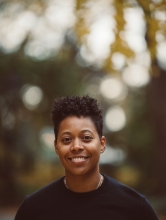By Jules Csillag and Lindsey Foster
This is part 2 of a 3-part series about school building reopenings, education, equity, and disability. Part 1 of this series introduces key terms, concepts, and the 2021 context.
"Pleasure is political & marginalized folx have our pleasure most denied, most policed...[so] pleasure is central to...our liberation. Pleasure is freedom."- Sami Schalk (she/her)
In the past year and a half, there were many examples of disabled Black people critiquing, thriving, struggling, resisting, and sharing their joy. For example, after co-authoring "Disability Solidarity: Completing the 'Vision for Black Lives'"–a valid critique of the Black Lives Matter movement leaving out the disability justice movement– Keri Gray (she/her) and Justice Shorter (she/her) organized a Black Disabled Lives Matter protest with their group, NAMD advocates. This event and the powerful visuals it produced could have been incorporated into many schools' curricula for students across ages and identities to engage in relevant and meaningful learning about intersectionality, representation, and organizing. Instead of prioritizing compliance, standardized testing, and assimilation, schools could have instead explored, celebrated, and created ways that demonstrate how access, intersectionality, and joy are intertwined, as expressed by Timotheus "TJ" Gordon (he/him): "Black joy is becoming more accessible to everyone! What better example to highlight that accessibility than how black disabled people are coping with the COVID-19 pandemic...we can be unapologetically black AND disabled at the same time!"
Inspired by disabled Black artists, activists, scholars, etc, we offer some practical strategies for your learning spaces. We encourage you to apply them, where relevant, and also want to invite you to continue to learn from disabled BIPOC. If you're not sure where to start, the links within this series may be a good launchpad.
Intersectional Representation
"The face of the disability community is very white. People don’t often think of people of color or of LGBTQ+ people when they think of us. Instead, they think of cis white male wheelchair users who hate themselves, because that is so often the way pop culture depicts us. I’m not a cis heterosexual white male wheelchair user, so in pop culture, I don’t exist. That’s not okay because it’s not reality. I exist, I am a real person behind these words, and I deserve to be seen." -Keah Brown (she/her)
|
Instead of... |
Try... |
|
Using only pre-made curricula (which are often offensive, filled with erasure, and not representative of student populations) |
With your colleagues and students (this is too big for solo work!), seek out historical and current examples of disabled Black people resisting, creating, and making change, and infuse these into your existing curriculum.
This can look like: · Use the Culturally Responsive Curriculum Scorecards to audit your existing curricula · Go beyond the curriculum: do any of your stock photos center disabled BIPOC? Do your coloring pages? Alphabet books? (remember to think intersectionally beyond race and disability, too) · Because erasure is such a part of sick/disability history, with your students, learn about multiple sides of people's identities that may already be in your curriculum (e.g. Fannie Lou Hamer, Rosa Parks, Sojourner Truth, Harriet Tubman, Audre Lorde, Marsha P Johnson, to name a few). · The above examples are also an invitation for you and your students to uplift your own role models, create your own images & examples, and invite in relevant community members to exemplify the expertise of all kinds of people. |
Resistance & Solidarity
"Traditionally, teachers' and schools' needs are centered...DisCrit solidarity rejects notions of managing individual or whole class behaviors, as these conversations are predicated on the notion of fixing students…Resistance in all its forms must be viewed as strengths, connected to the structural inequities students face, and channeled into action." - Subini Annamma (she/her)
|
Instead of... |
Try... |
|
Prioritizing classroom management techniques (including , reward systems, "disciplinary" practices, etc) over student engagement and teaching |
Students are more able to learn when they feel accepted, and educators may find more meaning in their work when they're in solidarity with their students.
This can look like: · Invite your students to share what's important to them. Then, co-create assignments and/or incorporate these into your curriculum. Providing choices is one way to support student interest and investment, and it's also important to be intentional about how & where students see themselves and what matters to them in the curriculum (see also the tip above). · Be transparent: Explore how people (especially disabled Black people) have resisted in the past, including alongside other groups (i.e. cross-movement solidarity & for collective liberation). This can be done across developmental levels since younger learners, too, have a sense of justice and can understand the desire to make change. · Empower your students to advocate since advocacy “is a natural response to the injustices and inequality in the world."-Ki’Tay Davidson (he/him), and join/support them in these efforts! |
Creative learning
"Often the Neurodiverse community are excluded from artistic narratives and creative spaces, thus we gladly create our own, taking ownership of our stories and telling them how we choose to tell them. Unfiltered and honest. My role as a mom is to help my Autistic son embrace his playfulness, as I continue to embrace mine." -Jen White Johnson (she/her)
|
Instead of... |
Try... |
|
Teaching academics in traditional ways, which often means separating them from the arts and other creative pursuits (e.g. science and collaborative learning) |
Infuse your academics with options for diverse types of learning & demonstrations of learning.
This can look like: · For learning, students could be given the option to watch a video, interview someone, do an experiment, read something, explore art based on a topic, etc. · For demonstrating learning, students could be given the option to create an infographic, create a comic, design something, put on a play, write something, make a podcast, etc. · You can also communicate the importance of arts, creativity, and community in your classroom routines, visuals/environments, and teaching methods. |



